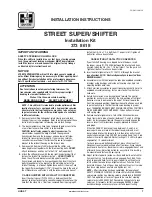
Research has shown that seat belts save lives, and they
can reduce the seriousness of injuries in a collision. Some
of the worst injuries happen when people are thrown
from the vehicle. Seat belts reduce the possibility of
ejection and the risk of injury caused by striking the
inside of the vehicle.
Everyone
in a motor vehicle should
be belted at all times.
Lap/Shoulder Belts
All seating positions in your vehicle are equipped with
lap/shoulder belts.
The belt webbing retractor is designed to lock during
very sudden stops or impacts. This feature allows the
shoulder part of the belt to move freely with you under
normal conditions. However, in a collision, the belt will
lock and reduce your risk of striking the inside of the
vehicle or being thrown out.
WARNING!
•
It is extremely dangerous to ride in a cargo area, inside or
outside of a vehicle. In a collision, people riding in these
areas are more likely to be seriously injured or killed.
•
Do not allow people to ride in any area of your vehicle that
is not equipped with seats and seat belts.
•
Be sure everyone in your vehicle is in a seat and using a seat
belt properly.
•
Wearing a seat belt incorrectly is dangerous. Seat belts are
designed to go around the large bones of your body. These
are the strongest parts of your body and can take the forces
of a collision best.
•
Wearing your belt in the wrong place could make your
injuries in a collision much worse. You might suffer internal
injuries, or you could even slide out of part of the belt.
Follow these instructions to wear your seat belt safely and to
keep your passengers safe, too.
•
Two people should never be belted into a single seat belt.
People belted together can crash into one another in an
accident, hurting one another badly. Never use a lap/
shoulder belt or a lap belt for more than one person, no
matter what their size.
THINGS TO KNOW BEFORE STARTING YOUR VEHICLE
39
2
Summary of Contents for 2008 DX-49 Magnum SRT8
Page 1: ...Magnum SRT8 O W N E R S M A N U A L 2 0 0 8...
Page 4: ......
Page 7: ...INTRODUCTION 5 1...
Page 10: ......
Page 80: ......
Page 110: ...108 UNDERSTANDING THE FEATURES OF YOUR VEHICLE...
Page 111: ...UNDERSTANDING THE FEATURES OF YOUR VEHICLE 109 3...
Page 112: ...110 UNDERSTANDING THE FEATURES OF YOUR VEHICLE...
Page 176: ...PREMIUM INSTRUMENT CLUSTER 174 UNDERSTANDING YOUR INSTRUMENT PANEL...
Page 266: ...264 UNDERSTANDING YOUR INSTRUMENT PANEL...
Page 274: ......
Page 317: ...STARTING AND OPERATING 315 5...
Page 364: ......
Page 434: ......
Page 442: ......
Page 453: ...INDEX 10...
















































